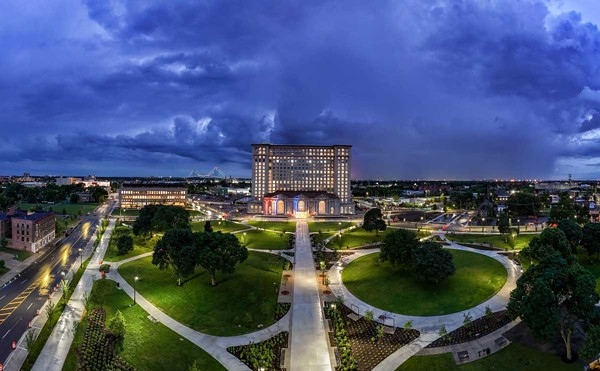I've never really heard the term lower east side used in reference to Detroit. I've heard of the near east side and far east side, but the lower east side sounds like some kind of New York thing. As it turns out, though, the folks on the lower east side know exactly where they are and who they are. Possibly most important at this point, they now have a plan to continue being there in the future.
Phase I of the Lower Eastside Action Plan (LEAP), created by a clutch of eastside community development groups and primarily funded by the Erb Family Foundation, was formally rolled out last week at the Northeast Guidance Center, where more than 100 people squeezed into a meeting room to see a multimedia presentation. Most of the folks in the room were familiar with parts of the plan because they are the ones who've done the work of putting it together over the past two years.
Some of them literally went street by street, house by house and lot by lot through the area bounded by the Detroit River on the south, I-94 on the north, Mount Elliott on the west and Alter to the east — making up about 15.5 of the city's 139 square miles — in order to know exactly what is there and in what condition. There are so many community organizations, churches, businesses and foundations involved in this massive undertaking that it would take up at least half this column space just to list them. But if last Thursday's meeting was any indication, those community groups can get their people out and involved — which bodes well for this from-the-ground-up effort.
Getting people involved may be the most important part of the process. Rather than saying "something needs to be done," these people are saying, "I'm going to do something about this." Maybe that's just the point many Detroiters have come to — nobody's going to save us but ourselves. The bottom line is that involved citizens can make an impact; uninterested people won't.
"What I took away from the process is the community's ability to really grasp very technical information," says Khalil Ligon, project manager for LEAP. "We tried to make it user-friendly and use information in a nonjudgmental way. They were able to take that information and digest it and use it to shape plans for their neighborhoods and make very sensible choices. That really stood out for me — how people were able to take that information and shape a plan. They got it. ...
"Instead of waiting around for something to be done, LEAP is a collective community response to the conditions of our neighborhood."
LEAP is broken down into short-term interventions and long-term goals. There's little that is amazing and new about these plans: things like neighborhood stabilization, urban agriculture, greenways and business stimulation. We've heard about this kind of stuff before. What makes it stand out are not the goals but the level of buy-in from the community, the use of uniform criteria to evaluate proposed efforts in varied neighborhoods, and the step-by-step process established for getting things accomplished.
Every proposal faces the same set of questions: how it will affect neighborhood stabilization, what's the impact on the immediate area, what's the economic benefit, what's the environmental impact and how does it benefit the city in general?
One project is the Community-Based Food Processing Business Incubator sponsored by the Eastern Market Corporation and GenesisHOPE Community Development Corporation. There's recently been a movement to grow food on the city's vacant land, but the effort has mostly resulted in putting fresh produce onto the tables of growers. There hasn't been much done in terms of developing local food businesses from them. LEAP hopes to bridge that gap by using the old decommissioned Marcus Garvey Jr. school building and the new active Garvey school with their commercial kitchens for food processing and to create a small business incubator to nurture food product businesses. Jeanine Hatcher, executive director of GenesisHOPE, says this will repurpose land and buildings, increase access to healthy food, and create viable businesses that will generate jobs. LEAP will be seeking matching funds from the United States Department of Agriculture this coming fall to make this project more viable.
One of the most potentially visible plans is the Mack Avenue Green Thoroughfare Project sponsored by the Warren Conner Development Corporation and Eastside LAND, Inc. This project seeks the demolition of abandoned commercial buildings so that low-maintenance greenery can be planted on the lots. This will improve safety and clean up the neighborhood in the short term. In the long term, the cleaned-up land may be attractive to future business ventures. In addition, the plan has provisions for working with local businesses in the blighted areas to help them move to more densely populated areas on Mack or elsewhere in the neighborhood.
Hantz Farms, a private business project that engendered some local controversy a couple of years ago, has gotten behind a Horticultural and Hydroponic Commercial Farm. This is very different from the first flag the organization ran up the pole. A big difference is that they now have buy-in from locals who plan to lobby City Council on behalf of the project. Hantz Farms plans to utilize as much as 500 acres of land to create a commercial forest of high-value hardwood trees, a Christmas tree farm, orchards and indoor hydroponic growing sites. LEAP members will serve on the farm's advisory board. A representative from Hantz Farms said there will be a limited number of jobs available that pay $10 per hour with benefits.
There's plenty more in the plan, such as a Villages Neighborhood Stabilization Initiative to rehabilitate homes and revitalize commercial areas in the Indian Village, East Village, West Village and Islandview Village neighborhoods, and a Jefferson-Chalmers Stabilization project.
"I'm excited," says Joan Moss, executive director of the Church of the Messiah Housing Corporation. "City planners and funders are listening to what we want to do."
Marja Winters, deputy director of the city Planning and Development Department, and City Council President Charles Pugh both spoke briefly, giving witness that the city is paying attention to LEAP's efforts. In fact, a city liaison has been part of the process, so it seems there will be cooperation from downtown in terms of making things happen and maybe no disconnect when it comes to city plans that may affect the area.
"The biggest thing about this project is not the plan but bringing the people from this large footprint together to come up with these solutions together," says Ligon. "Giving them the opportunity to create, rather than someone coming in and saying this is what's going to happen in your community."
There was passing mention of light manufacturing of hydroponic growing systems and the possibility of a fish farm, but those are not on the table in the short term. I've heard a lot of plans to change things in Detroit but this one seems the most well thought out in terms of coordinating ideas and resources. Maybe it will be a giant leap forward for our friends on the lower eastside. If so, it will be a victory for all of us.






